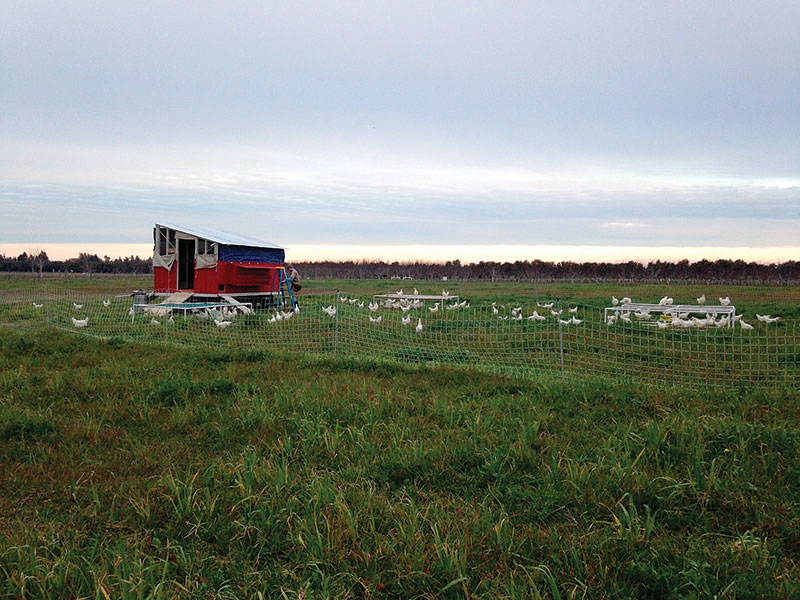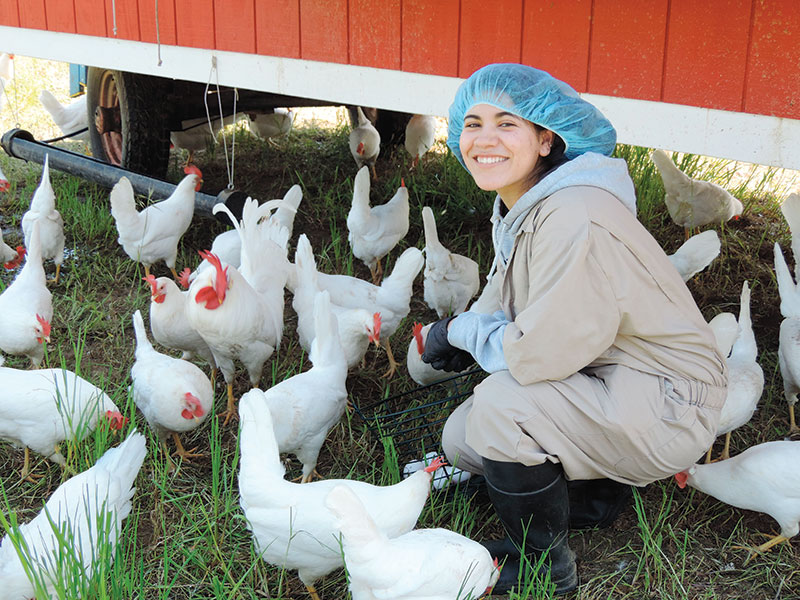
Backyard-poultry enthusiasts often confuse the terms “free-range” and “pastured” poultry and wonder which of these husbandry styles is applicable to their own backyard flocks.
As a reminder, there is no perfect animal-production system. Sickness and death are part of animal agriculture. Therefore, our goal is to better understand the advantages and disadvantages of different husbandry systems with respect to poultry health, food safety, welfare, production efficiency and the environment in order to mitigate any potential problems. Regardless of which method you use, having knowledge of different approaches and an open, curious and critical mind are essential for the overall health of your flock.
What Is Free-Range?

In a general sense, free-range is a loose term for any system that does not use cages and provides access to an outdoor area that is fenced in and may also have some type of netting or fencing over it. Free-range chickens are housed in a stationary indoor space with nest boxes, perches and often unlimited access to the fenced and/or netted outdoor space.
Your setup may be very similar to this except that you keep your flock in a protected coop at night as opposed to giving them 24/7 access to the outdoors. By providing an area outside the coop that is fenced or netted in, you mitigate the risk of mortality from predators, which is the most common cause of mortality for poultry raised outdoors, based on our lab research.
What Is Pastured Poultry?

Pastured poultry is similar to free-range with respect to access to the outdoors except the birds are typically housed in a mobile coop with nest boxes, perches and shelter. The coop is movable because if it and the flock were left in the same area, the pasture would eventually be denuded by the poultry. A mobile coop can be easily moved as necessary to a new patch of pasture and let the older patch recover.
In a typical pastured system, the birds spend the night in the mobile coop and only have daytime access to pasture. Keeping birds locked up at night reduces mortality from predators and is more secure than giving your flock 24/7 access to the outdoors.
Considerations For Mobile Coops
Many mobile coops have slatted floors, which allow the manure to drop down to the pasture. While this is ideal from a fertilization perspective, those same slotted floors can also allow wildlife to get into the coop, meaning predation of and disease transmission to your birds. Poultry also often congregate under the slotted floors during the day to seek shade and shelter, so any chickens still in the coop will defecate on the birds underneath them, increasing the transmission of diseases within the flock.
For these reasons, solid floors are often ideal for pastured-poultry flocks. However, if you still want to use slotted floors, consider offering shade and shelter in multiple locations—think trees or man-made structures—to draw the birds away from the mobile coop. This has the added advantage of increasing the area the birds are defecating in.
The Pasture Advantage
Advantages to raising poultry on pasture include reductions in feed cost and changes in the nutritional content and characteristics of eggs. Specifically, eggs from pasture-raised chickens have been reported to have higher levels of omega-3 fatty acids, vitamin A and vitamin E, all thought to be beneficial for human health.
As the name implies, you need to have pasture to have pastured poultry. In your backyard, you can use your lawn as a pasture. However, you should also consider supplementing your flock’s diet with commercially available all-purpose forage mixes. While chickens do eat grasses, most of the nutritional value they get is from the seeds and insects in your pasture, which are more common in diverse environments. If your backyard lawn does not have much variety, consider reseeding it with a commercial pasture seed mix.
Working With The Weather & Land
Chicken keepers in the western U.S., which is going through a historic drought, may consider trying a seasonal pastured system, where you plant your pasture in the fall and use minimal irrigation until late spring. By allowing the pasture to die off in the summer, you can have a hybrid nonpastured poultry system during the dry months and then re-seed again in the fall in anticipation of the rainy season. Water savings can be significant, and this modified approach reflects the importance of considering different options that dovetail with your specific environment.
Most pastured-poultry operations utilize a pasture rotation system to prevent overgrazing of their pasture and to fertilize the land in a systematic way. While there are no set guidelines as to when or how often to rotate pasture, the simplest rule is to never let the pasture grow below 2 inches. Based on that rule and allowing a minimum of 5 square feet per bird on the pasture, you can experiment and develop a rotational system that works for your backyard.
Wildlife Control For Chickens

Perhaps the biggest hurdle faced by backy-ard enthusiasts who do some type of free-range and/or pastured poultry is wildlife control. Anecdotal and survey-based observations indicate that predation is the No. 1 cause for mortalities in these systems, so if you live in an area where predators including coyotes, bears, skunks, opossums, raccoons and hawks are common, you should consider the following preventative measures.
- Use 1/4 inch-wide hardware cloth instead of chicken wire for fencing. Hardware cloth is thicker and more difficult for predators to break through.
- For permanent fencing, 2 to 3 feet of hardware cloth can be dug underneath the perimeter of the coop for extra protection. This makes it more difficult for predators to dig under the fence. In addition, apply gravel where the fence line meets the ground (6 inches deep and across). Fences are only as strong as their weakest link, so, for example, if you have a gate that has a gap between the bottom of the gate and the ground, wildlife will find it and use it.
- Provide multiple shade options, including trees and man-made structures. These structures encourage birds to graze over more land and provide shelter from aerial predators (e.g., hawks and owls). While netting and fencing can help keep out wildlife, a combination of management practices is really needed to optimize predator control. Like with other aspects of poultry ownership, there is no silver bullet for wildlife control, so try out a few of these strategies and see what works best for your system.
- Devices that use reflective material, such as wildlife repellent tape, scary eyes and terror balloons, can scare other birds and some predators, as well.
- Coyote/fox decoys can scare away waterfowl, but adaptation to these decoys has been reported. You should move them around regularly and maybe even take a break from using them every now and again.
- Electronic bird repellents use bird sounds to scare off other problem birds. Usually they come with some sort of random order mode to prevent adaptation to sounds. They were originally used for vineyards but have been helpful in other animal operations.
While these recommendations can be used in free-range or pastured-poultry operations, the use of portable electric fences are often used in pastured systems to outline the borders of a new pasture specific to where the mobile coop has been moved. The goal here is to fence off an area of at least 5 square feet per bird and to mitigate wildlife intrusion. While this kind of fence is less than ideal, as it doesn’t keep out all wildlife, it can help keep larger predators out of the grazing area.
Backyard Chicken-Keeping Best Practices

The following are some general rules that can be applied for backyard free-range and pastured-poultry management. Note: If you are commercially selling your eggs, consider consulting with an independent auditing group. There is currently no consensus regarding stocking density between the different auditing groups, and for our purposes, we are providing guidelines that are the most inclusive.
- The stocking density for the inside of the coop should be at least 2 square feet per bird. Outside, provide at least 5 square feet per bird.
- If you plan to use the fertilized land as cropland, it’s very important to keep food safety in mind. According to the USDA’s National Organic Program, touch crops—crops harvested from the ground, such as carrots and lettuce—should not have raw manure applied on them less than 120 days before harvest. In the case of no-touch crops—crops that have no direct contact to the ground, such as fruit trees—they should not have manure applied on them less than 90 days before harvest. The purpose of these recommended lag times is to avoid bacterial cross-contamination between raw manure and crops that will be used for human consumption.
Free-range and pastured-poultry farming are becoming more common for backyard chicken keepers and commercial producers alike. Backyard enthusiasts have the advantage of operational flexibility with respect to selecting the husbandry practices they prefer. However, no system is perfect. The more we learn about every system, the more we can mix and match to make an optimal backyard environment for our flock and ourselves.
Poultry Science is written by faculty and staff from the School of Veterinary Medicine at the University of California, Davis (www.vetmed.ucdavis.edu) and University of California Cooperative Extension (www.ucanr.edu). This column was written by Myrna Cadena and Dr. Maurice Pitesky, D.V.M., M.P.V.M., D.A.C.V.P.M. Pitesky specializes in poultry health and food safety epidemiology.
This article originally appeared in the January/February 2017 issue of Chickens.




